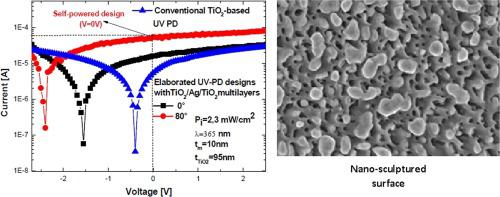当前位置:
X-MOL 学术
›
Appl. Surf. Sci.
›
论文详情
Our official English website, www.x-mol.net, welcomes your
feedback! (Note: you will need to create a separate account there.)
Highly improved responsivity of self-powered UV-Visible photodetector based on TiO2/Ag/TiO2 multilayer deposited by GLAD technique: Effects of oriented columns and nano-sculptured surface
Applied Surface Science ( IF 6.3 ) Pub Date : 2020-11-01 , DOI: 10.1016/j.apsusc.2020.147069 H. Ferhati , F. Djeffal , N. Martin
Applied Surface Science ( IF 6.3 ) Pub Date : 2020-11-01 , DOI: 10.1016/j.apsusc.2020.147069 H. Ferhati , F. Djeffal , N. Martin

|
Abstract The outstanding progress made in optoelectronic technologies calls for a renewed performance assessment of photodetectors (PDs) for next-generation sensing applications. Here, TiO2/Ag/TiO2 tri-layered films were sputtered using the GLancing Angle Deposition (GLAD) technique in which the deposition angle was varied from 0 to 80°. Before the elaboration, a strategic combination of Genetic Algorithm (GA) and numerical analysis was used to find out the best multilayer geometry offering superior optical performance. The influence of the inclined architecture on the performance of the prepared TiO2/Ag/TiO2 multilayer was analyzed. Optical characterization reveals that near-perfect UV photodetection and over than 60% of visible-absorbance were achieved by taking a deposition angle of 80°. These enhancements are correlated to the surface nano-sculptured structures, which gives rise to an enhanced light-trapping capability. The measured I-V curves of the obliquely-deposited structures showed a clear photovoltaic mode and an extremely low dark current of a few picoamperes. Besides, the devices demonstrate an enhanced self-powered UV–Vis photoresponse, yielding superb UV and visible responsivity of 0.2A/W and 47 mA/W, respectively. The UV, blue, and green current ratios were respectively 137, 113, and 107 dB. Therefore, promoting efficient light management, this innovative concept of inclined tri-layer films provides a sound pathway for designing potential alternative self-powered UV–Vis PDs appropriate for the future development of the optoelectronic technology.
中文翻译:

基于通过 GLAD 技术沉积的 TiO2/Ag/TiO2 多层膜的自供电紫外-可见光探测器的高度提高的响应度:定向柱和纳米雕刻表面的影响
摘要 光电技术取得的显着进步要求对用于下一代传感应用的光电探测器 (PD) 进行新的性能评估。在这里,使用 GLancing 角沉积 (GLAD) 技术溅射 TiO2/Ag/TiO2 三层薄膜,其中沉积角从 0 到 80° 变化。在详细说明之前,使用遗传算法 (GA) 和数值分析的战略组合来找出提供卓越光学性能的最佳多层几何结构。分析了倾斜结构对制备的 TiO2/Ag/TiO2 多层膜性能的影响。光学表征表明,通过采用 80° 的沉积角,可以实现近乎完美的紫外光电检测和超过 60% 的可见光吸收率。这些增强与表面纳米雕刻结构相关,从而增强了光捕获能力。倾斜沉积结构的测量IV曲线显示出清晰的光伏模式和几皮安的极低暗电流。此外,这些器件表现出增强的自供电 UV-Vis 光响应,分别产生了 0.2A/W 和 47mA/W 的极好的紫外和可见光响应率。UV、蓝色和绿色电流比分别为 137、113 和 107 dB。因此,为了促进高效的光管理,这种倾斜三层薄膜的创新概念为设计适合光电技术未来发展的潜在替代自供电 UV-Vis PD 提供了良好的途径。这导致增强的光捕获能力。倾斜沉积结构的测量IV曲线显示出清晰的光伏模式和几皮安的极低暗电流。此外,这些器件表现出增强的自供电 UV-Vis 光响应,分别产生了 0.2A/W 和 47mA/W 的极好的紫外和可见光响应率。UV、蓝色和绿色电流比分别为 137、113 和 107 dB。因此,为了促进高效的光管理,这种倾斜三层薄膜的创新概念为设计适合光电技术未来发展的潜在替代自供电 UV-Vis PD 提供了良好的途径。这导致增强的光捕获能力。倾斜沉积结构的测量IV曲线显示出清晰的光伏模式和几皮安的极低暗电流。此外,这些器件表现出增强的自供电 UV-Vis 光响应,分别产生了 0.2A/W 和 47mA/W 的极好的紫外和可见光响应率。UV、蓝色和绿色电流比分别为 137、113 和 107 dB。因此,为了促进高效的光管理,这种倾斜三层薄膜的创新概念为设计适合光电技术未来发展的潜在替代自供电 UV-Vis PD 提供了良好的途径。倾斜沉积结构的测量IV曲线显示出清晰的光伏模式和几皮安的极低暗电流。此外,这些器件表现出增强的自供电 UV-Vis 光响应,分别产生了 0.2A/W 和 47mA/W 的极好的紫外和可见光响应率。UV、蓝色和绿色电流比分别为 137、113 和 107 dB。因此,为了促进高效的光管理,这种倾斜三层薄膜的创新概念为设计适合光电技术未来发展的潜在替代自供电 UV-Vis PD 提供了良好的途径。倾斜沉积结构的测量IV曲线显示出清晰的光伏模式和几皮安的极低暗电流。此外,这些器件表现出增强的自供电 UV-Vis 光响应,分别产生了 0.2A/W 和 47mA/W 的极好的紫外和可见光响应率。UV、蓝色和绿色电流比分别为 137、113 和 107 dB。因此,为了促进高效的光管理,这种倾斜三层薄膜的创新概念为设计适合光电技术未来发展的潜在替代自供电 UV-Vis PD 提供了良好的途径。和绿色电流比分别为 137、113 和 107 dB。因此,为了促进高效的光管理,这种倾斜三层薄膜的创新概念为设计适合光电技术未来发展的潜在替代自供电 UV-Vis PD 提供了良好的途径。和绿色电流比分别为 137、113 和 107 dB。因此,为了促进高效的光管理,这种倾斜三层薄膜的创新概念为设计适合光电技术未来发展的潜在替代自供电 UV-Vis PD 提供了良好的途径。
更新日期:2020-11-01
中文翻译:

基于通过 GLAD 技术沉积的 TiO2/Ag/TiO2 多层膜的自供电紫外-可见光探测器的高度提高的响应度:定向柱和纳米雕刻表面的影响
摘要 光电技术取得的显着进步要求对用于下一代传感应用的光电探测器 (PD) 进行新的性能评估。在这里,使用 GLancing 角沉积 (GLAD) 技术溅射 TiO2/Ag/TiO2 三层薄膜,其中沉积角从 0 到 80° 变化。在详细说明之前,使用遗传算法 (GA) 和数值分析的战略组合来找出提供卓越光学性能的最佳多层几何结构。分析了倾斜结构对制备的 TiO2/Ag/TiO2 多层膜性能的影响。光学表征表明,通过采用 80° 的沉积角,可以实现近乎完美的紫外光电检测和超过 60% 的可见光吸收率。这些增强与表面纳米雕刻结构相关,从而增强了光捕获能力。倾斜沉积结构的测量IV曲线显示出清晰的光伏模式和几皮安的极低暗电流。此外,这些器件表现出增强的自供电 UV-Vis 光响应,分别产生了 0.2A/W 和 47mA/W 的极好的紫外和可见光响应率。UV、蓝色和绿色电流比分别为 137、113 和 107 dB。因此,为了促进高效的光管理,这种倾斜三层薄膜的创新概念为设计适合光电技术未来发展的潜在替代自供电 UV-Vis PD 提供了良好的途径。这导致增强的光捕获能力。倾斜沉积结构的测量IV曲线显示出清晰的光伏模式和几皮安的极低暗电流。此外,这些器件表现出增强的自供电 UV-Vis 光响应,分别产生了 0.2A/W 和 47mA/W 的极好的紫外和可见光响应率。UV、蓝色和绿色电流比分别为 137、113 和 107 dB。因此,为了促进高效的光管理,这种倾斜三层薄膜的创新概念为设计适合光电技术未来发展的潜在替代自供电 UV-Vis PD 提供了良好的途径。这导致增强的光捕获能力。倾斜沉积结构的测量IV曲线显示出清晰的光伏模式和几皮安的极低暗电流。此外,这些器件表现出增强的自供电 UV-Vis 光响应,分别产生了 0.2A/W 和 47mA/W 的极好的紫外和可见光响应率。UV、蓝色和绿色电流比分别为 137、113 和 107 dB。因此,为了促进高效的光管理,这种倾斜三层薄膜的创新概念为设计适合光电技术未来发展的潜在替代自供电 UV-Vis PD 提供了良好的途径。倾斜沉积结构的测量IV曲线显示出清晰的光伏模式和几皮安的极低暗电流。此外,这些器件表现出增强的自供电 UV-Vis 光响应,分别产生了 0.2A/W 和 47mA/W 的极好的紫外和可见光响应率。UV、蓝色和绿色电流比分别为 137、113 和 107 dB。因此,为了促进高效的光管理,这种倾斜三层薄膜的创新概念为设计适合光电技术未来发展的潜在替代自供电 UV-Vis PD 提供了良好的途径。倾斜沉积结构的测量IV曲线显示出清晰的光伏模式和几皮安的极低暗电流。此外,这些器件表现出增强的自供电 UV-Vis 光响应,分别产生了 0.2A/W 和 47mA/W 的极好的紫外和可见光响应率。UV、蓝色和绿色电流比分别为 137、113 和 107 dB。因此,为了促进高效的光管理,这种倾斜三层薄膜的创新概念为设计适合光电技术未来发展的潜在替代自供电 UV-Vis PD 提供了良好的途径。和绿色电流比分别为 137、113 和 107 dB。因此,为了促进高效的光管理,这种倾斜三层薄膜的创新概念为设计适合光电技术未来发展的潜在替代自供电 UV-Vis PD 提供了良好的途径。和绿色电流比分别为 137、113 和 107 dB。因此,为了促进高效的光管理,这种倾斜三层薄膜的创新概念为设计适合光电技术未来发展的潜在替代自供电 UV-Vis PD 提供了良好的途径。











































 京公网安备 11010802027423号
京公网安备 11010802027423号